Lactofermentation
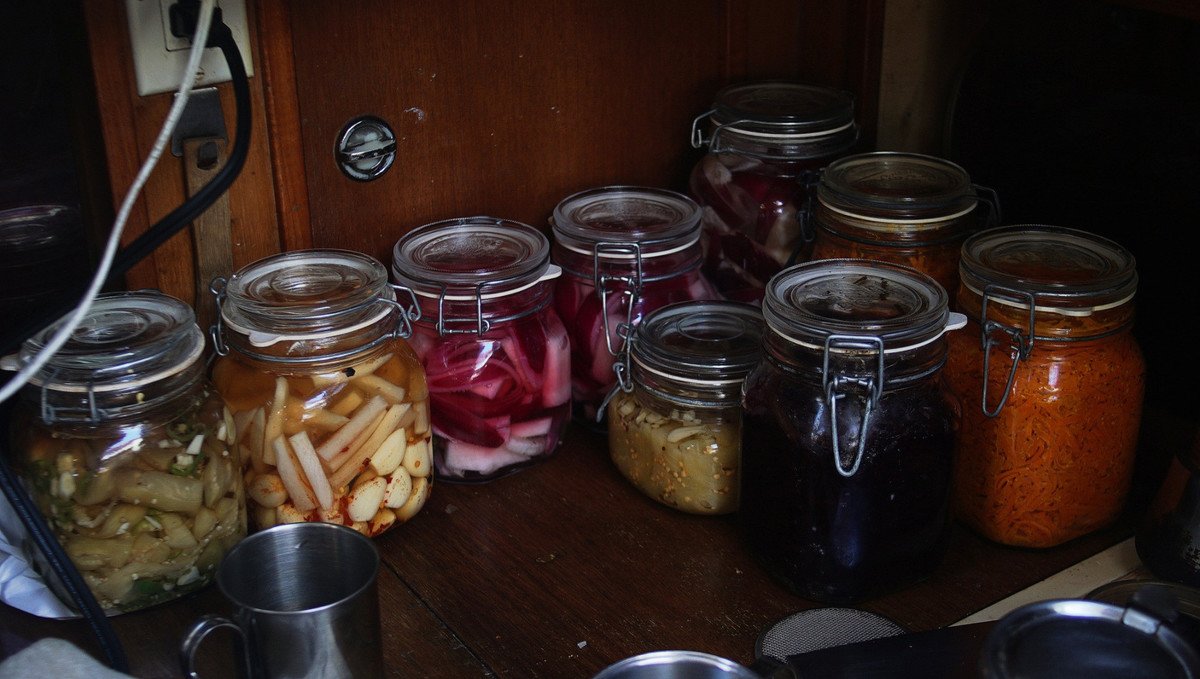
Lacto-fermentation(Lactic acid fermentation) is a way to preserve any vegetable using salt, and the bacterium (lactobacillus) already present on the vegetables. Other bacteria which produce lactic acid include: leuconostoc mesenteroides, pediococcus cerevisiae, streptococcus lactis (dairy), and bifidobacterium bifidus(live in your intestinal tract).
When microbial activity occurs, lactic acid is secreted, as well as CO2 and a variety of enzymes. Creating an acidic environment makes it near impossible for bad bacteria to establish themselves, even if they are present. Over time, the mixture eventually achieves a state of balance, and fermentation stops. Conserving vegetables this way can last many years, even when stored at room temperature.
Preserving food by lacto-fermentation keeps vitamins intact, and in some vegetables, increases its nutritional value. Fermentation also improves the immune system, and digestibility of the food, making them easier for our systems to assimilate.
General Tips
- Limit air space: A half-filled jar is guaranteed failure.
- Don't open jars for 3-4 weeks: Keeping air out is essential to a good fermentation.
- Don't eyeball it: Weigh everything in the beginning, follow recipes exactly to get a feel for how many vegetables can fit in a jar.
- Ferment in the fall: Ones fermented in the fall will be more successful than in the summer. Winter veg stay firmer than summer veg.
Table of Contents
- Fermenting methods
- Temperature
- Salt
- Water
- Brine
- Sterilization
- Botulism
- Signs of a bad fermentation
- No fridge
- Shelf life
- Sunlight
- What kind of jar to use
- Weights
- What to do when a jar is opened
- Can you ferment all vegetables?
- Spices
- Summer vegetables
- Recommended vegetables
- Notes on specific vegetables
- Recipes
- Resources
Fermenting methods
Salting provides a good environment for lactic acid bacteria to grow while imparting the acid flavor to the vegetable. Generally, yeast, bacteria, and molds do not grow in saturated salt solution at 26.5% sodium chloride at room temperature.
Dry-salt method. The dry-salting method requires that vegetables be grated or shredded, for only with lots of surface area exposed can the salt pull water out of the vegetables. The salt extracts the juice from the vegetable and creates the brine. It's necessary to massage the vegetables and salt mix with your hands to help draw out the water. Let the mixture rest anywhere from 15-30 minutes, the shredded/grated veg needs to be soft, and humid. If there isn't enough water, massage and let the mixture rest longer. It is better not to add extra brine, because it will change the texture of the vegetables(they'll become soft). Compressing them in the jar will further remove more water, and eliminate air pockets between vegetables. This method is ideal for vegetables that contain lots of water like cabbage, carrots, and beets.Note. Once fermentation starts the water level may appear lower, this is because the grated/sliced vegetables expand, concealing the water still inside the jar.
Brine method. The brine method requires that the chopped vegetables be submerged in brine. The brine consists of pickling salt dissolved in water. This method is ideal for vegetables with less water content (ex: cauliflower, brussel sprouts, small white onions, etc) or those cut in large chunks (ex: large carrot chunks instead of julienned carrots). The brine ought to be cold, not warm (only exception is with cucumbers). Veg in brine may soften more than those processed using the dry-salt method. A strong brine solution will draw sugar and water out of the vegetable, which decreases the overall salt concentration.
In both cases, the brine prevents exposure to oxygen, creating the perfect environment for lacto-fermentation.
To start a fermentation, the vegetables and salt are put in jars and left to ferment on the counter for 7 days. >After a few days, the air will start getting pushed out by the fermentation gases. Place a plate under your jars. The jar may start fizzing, or spitting (depending on the veg or if you overfilled the jar).
After the first week, it's possible to move the jar off the counter (but not in a refrigerated space) to continue to ferment for 2-3 more weeks. After this time it's possible to eat it, or to keep it for long-term storage.
Temperature
An ambient temperature of 18º to 22º C (65-72°F) is ideal for starting fermentation since this is the optimum temperature range for the growth and metabolism of good bacteria.
Lower ambient temperatures will slow fermentation, and high temperatures will accelerate it, keep this in mind when starting fermentations.
Salt
When pickling vegetables it's possible to use any type of salt, such as table salt, pickling salt, fleur de sel, pink himalayan salt, kosher salt, sea salt, sel gris etc. Many sources recommended to use salts without added iodine or anti-caking agents, see why below.
Iodine. Iodine is added ot salt to prevent deficiencies. It's a widely-held belief that iodine kills the lactobacillus present on all fresh vegetables, a bacterium that is an essential part of the lactic-acid fermentation process, but I've read sources that seem to indicate that iodine has little influence on fermentation. It appears that lactic acid bacteria are tolerant to a wide variety of salts, including iodized table salt. To be fair, the value of using non-iodized salt when starting out is that when things go wrong you'll have reduced the number of possible reasons, making it quicker to identify the culprit.
Anti-caking agents. Anti-caking agents may cloud the brine.
The preferred salt type is ones with minerals present, like sea salt, or sel gris. It's possible to use fancier salts, like fleur de sel, sel gris, pink himalayan salt or black salt, but they're quite pricey and not worth the extra cost.
When pulling water out of the vegetables using the dry-salt method, add 10-20 g of salt per kg of vegetables, it's possible to add more for long-term preservation, or less if the goal is to eat them rapidly (10g per kg is usually enough). If you don't have a scale (although I recommend you get one, thrift stores are full of them), 1 tsp equals about 5g of salt.
Salt essentially slows fermentation and enzyme activity and thereby prolongs the preservation potential. The higher the salinity of the brine, the longer the fermentation is going to take. Temperature also impacts upon the speed of fermentation (fermentation occurs faster in summer than winter). If we preserve vegetables with the goal of eating them much later, we add more salt, if the goal is to eat it as soon as it's ready, we use less.
Water
Non-chlorinated water is ideal, because chlorine is antiseptic. Filter the water, or let it rest on the counter for a few hours to permit the chlorine to evaporate. Using chlorinated water doesn't mean the ferment will fail, but it can slow the process.
We've had luck with using water straight from our tank(the water in Victoria has chloramines), but if you want to guarantee results it may be best to leave the water to stand for a while first. Also, check that your water supply doesn't contain chloramines, a stable form of chlorine (mix of ammonia and chlorine) that doesn't evaporate at ambient temperature, and that can't be boiled out. It's possible to filter out chloramines with a good filter (berkey filters do this).
Chlorinated water won't necessarily stop fermentation from happening, but it can make it sluggish.
Brine
When fermenting vegetables in brine, a basic ratio of salt for 1% salinity is of approximately 30 g per liter of water, or 10 g of salt per kg of total vegetable+water weight, is necessary for vegetables. Again, it's possible to add up to 5% for long term preservation. Allow the salt to fully dissolve in the brine before using. Refer to the table below for the amount of salt necessary per water.
| Water | ||||||
| US cups | 1 cup | 2 cups | 3 1/4 cups | 4 cups | 8 cups | 16 cups |
| Metric | 236 ml | 473 ml | 750 ml | 946 ml | 1.89 l | 3.78 l |
| Brine % | Salt | |||||
| 1 % | 2 g | 5 g | 7 g | 9 g | 19 g | 38 g |
| 2 % | 5 g | 9 g | 15 g | 19 g | 38 g | 76 g |
| 2.5 % | 6 g | 12 g | 19 g | 24 g | 47 g | 94 g |
| 3 % | 7 g | 14 g | 22 g | 28 g | 57 g | 113 g |
| 3.5 % | 8 g | 17 g | 26 g | 33 g | 66 g | 132 g |
| 4 % | 9 g | 19 g | 30 g | 38 g | 76 g | 151 g |
| 5 % | 12 g | 24 g | 37 g | 47 g | 94 g | 189 g |
| 10 % | 24 g | 47 g | 75 g | 94 g | 189 g | 378 g |
| 20 % | 47 g | 94 g | 150 g | 189 g | 378 g | 755 g |
Information in above chart re-transcribed to text and sourced from the Fermentation Podcast. I appended the 750 ml (3 1/4 cups) row to this table, because it is a common size. Note that this is approximate. All salt weighs differently so it's necessary to experiment.
Sterilization
Clean your jars, hands and tools with warm soapy water, no need to sterilize them beforehand.
Can you ferment any vegetable?
The short answer is, yes, but not all might be palatable or keep their shape. Each vegetable reponds differently to fermentation. For instance, mushrooms tend to soften when lacto-fermented, and leafy greens will disintegrate.
Botulism?
Lacto-fermentation is generally safe because acidity is the enemy of botulism. The pH of the brine is low, therefore acidic, and so no pathogens can survive. If you have properly measured the salt, in relation to the quantity of vegetables, and followed directions to the letter (no air, non-iodized salt and non-chlorinated water) everything will be fine and the resulting product will be safe to eat.
Signs of a bad fermentation
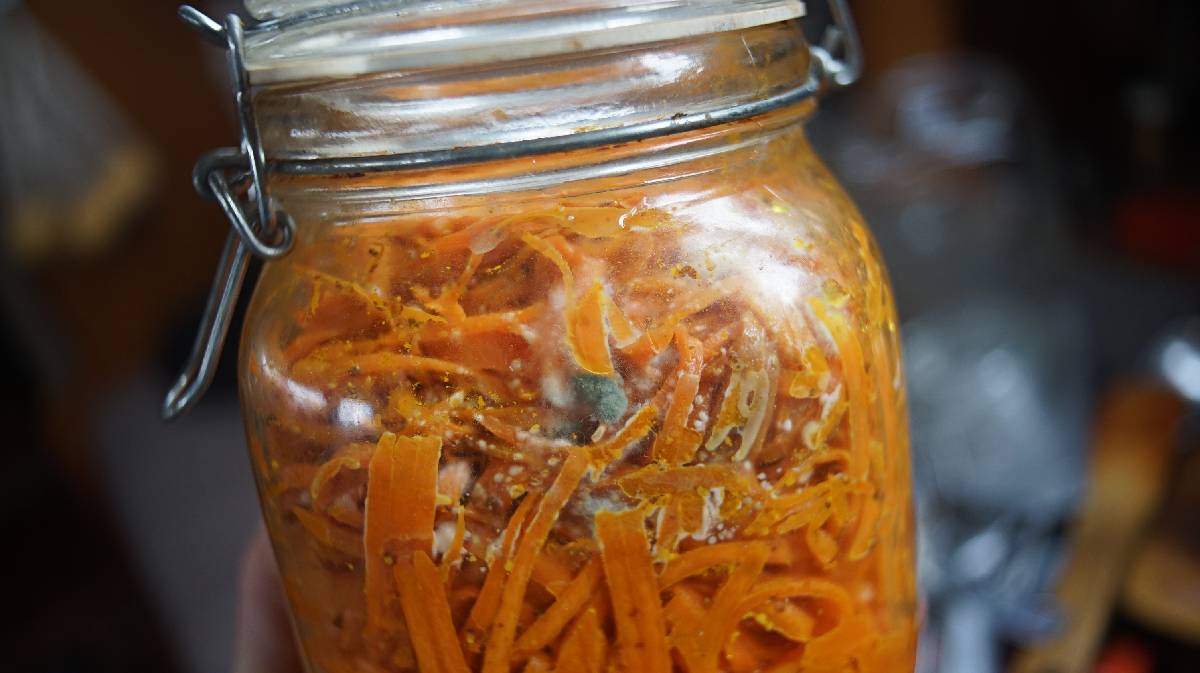
If a fermentation goes wrong, you'll be able to smell it, or it'll be visually apparent. A biofilm forming on the surface isn't necessarily a bad thing, there is both good and bad mold. If the surface film is thick and has weird coloring, or that the vegetable has turned to mush, then it's likely bad. As long as the mold is white it is not harmful. A sour smell is fine, but there's a big difference between sour and putrid, trust your nose.
Most problems occur after opening a jar, due too much exposure to air or high room temperatures. If you take the right precautions all should be fine.
Accidentally eating a bad lacto-fermented product is very unlikely. So far, we've only had one instance of mold (see above photo) due to a bad rubber seal. Oxygen found its way in, spoiling the fermentation.
No fridge
The jars are shelf-stable, you don't need to put them in the refrigerator. For long-term preservation, find a cool place away from light and heat. Once you open a jar, you may store it in the refrigerator, but if you're careful not to use dirty utensils to retrieve the content of the jar, it shouldn't be necessary, see What to do when a jar is opened for more information.
Shelf life of lacto-fermented foods
Unlike canned foods, most vegetables preserved by fermentation will not last forever. How long they last depends on the pH, salinity, how they're stored, overall humidity of the environment, etc.
Lacto-fermented foods are alive. Eventually they'll yield to other organisms and acidify, or soften to a point that will render it inedible. Fermenting foods this way prolongs their shelf life, but it is in no way infinite.
Sunlight
As a general rule, it is best to keep jars of fermenting foods away from direct sunlight. Away from sunlight doesn't mean they need to be kept in total darkness.
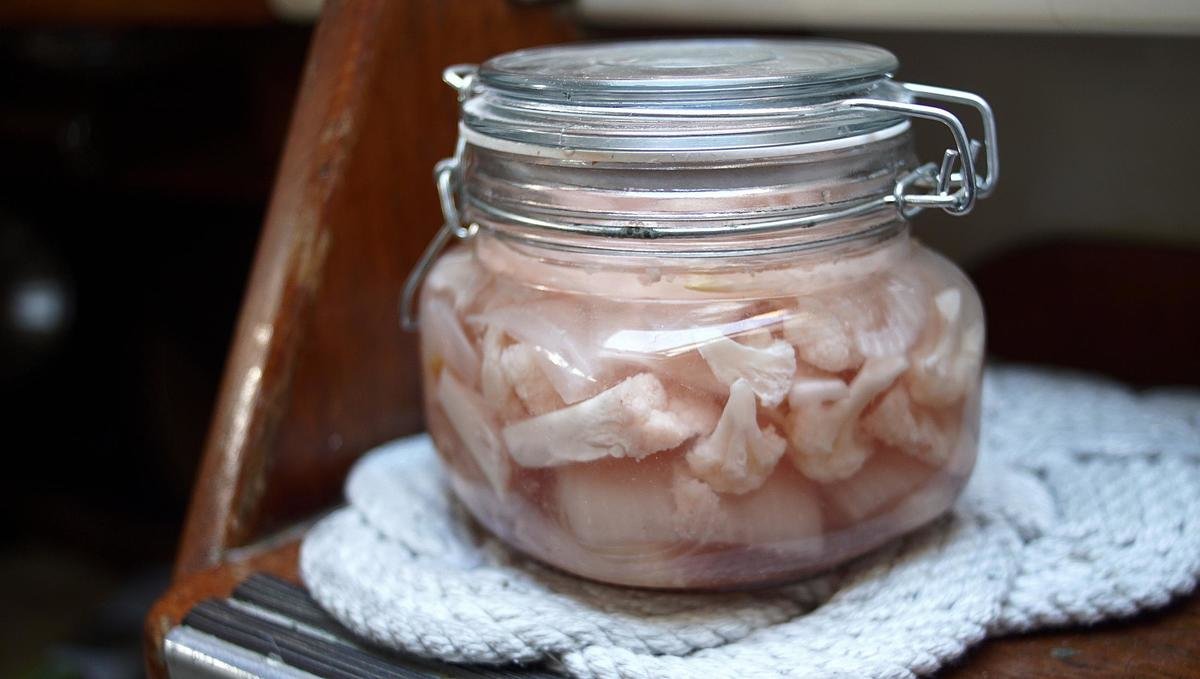
What kind of jar to use
Whichever vessel you choose, it's important to remember that you have to allow for the jars to 'burp' out CO2.
Spring-top jars. (See above image) Our favorite jar type is the spring-top variety with the rubber seal and metal fastenings. If under pressure, the jar will 'burp' itself without letting air inside. It is a simple, no-fuss option. Although the steel clamp/hinge assembly rust overtime (living on a boat doesn't help). Once in a while, we remove them and clean off the rust using our electric drill equipped with a brass wire sbrush. If the steel is too far gone, it may be possible to source some online using keywords like "Replacement Bale-Wire," "Replacement Wire Clamp," or "Replacement D-ring."
Jars with an air-lock. A regular jar topped with a lid and air-lock is a good option. The air-lock permits the air inside to escape while preventing outside air from entering.
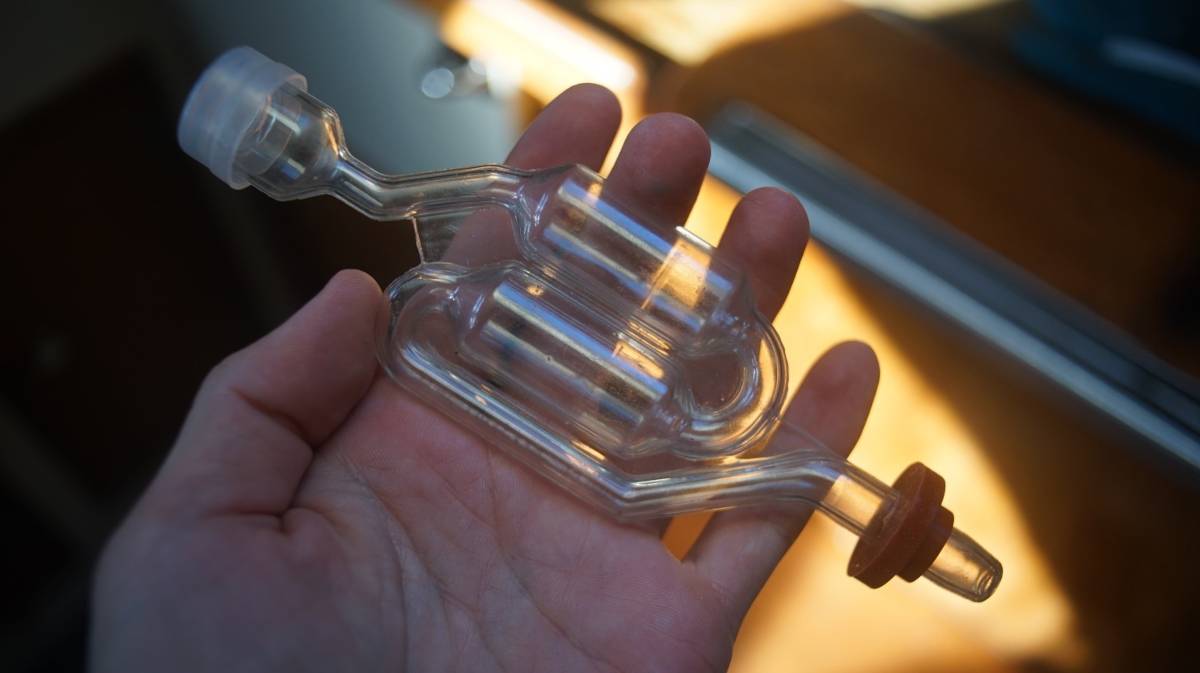
Crock. If you plan to process a lot of vegetables, using a larger, open container like a crock makes sense, but it's important to keep all vegetables well-submerged in the brine and to cover the container with a bag to keep air from coming in. "Cover the chopped salted vegetables with a plate that fits inside the crock and sits on the surface of the vegetables, then weigh the plate down, usually with a gallon-size jug full of water, to keep the vegetables submerged under their juices and thereby protect them from oxygen. Finally, I cover the whole setup with a cloth to keep flies out. Often, I tie a string around the cloth to secure it." (Sandor Katz) The important thing is that all vegetables stay in the brine during the fermentation period. This method isn't suitable for long-term preservation, it's necessary to transfer its contents to smaller jars after the 2 week fermentation period. This method is also useful if you plan to eat the vegetables right away, after the first week.
Canning jars. Using canning jars is fine, but the metal lids may corrode because of the acidity of the fermentation. It's better to use plastic lids. Also, it's necessary to burp the jars by hand, otherwise they may explode from the pressure. If using metal lids, the top of the jar will bulge outward, giving you clear signs that it needs to be burped. In general, it's a good idea to burp the jars once, or twice a day for the first few days.
Weights
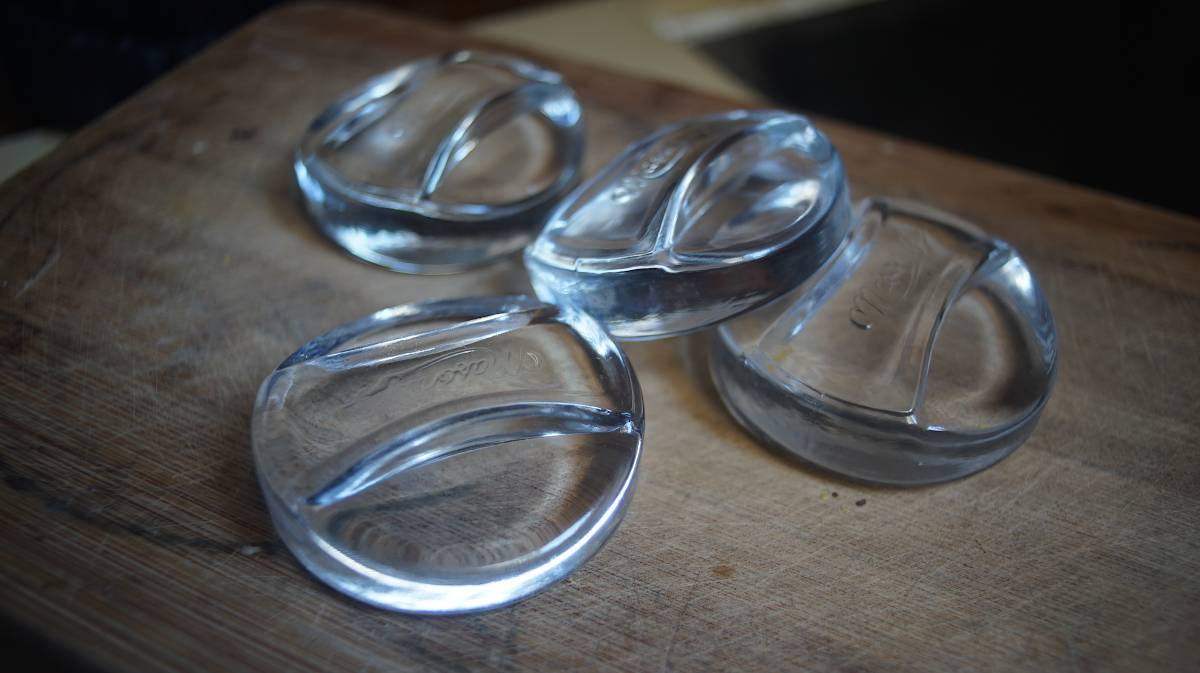
When lacto-fermenting, keeping vegetables submerged in a jar is important. Adding a weight can help, but it is not always necessary. If vegetables are packed tightly into a jar they may not get the chance to float to the surface.
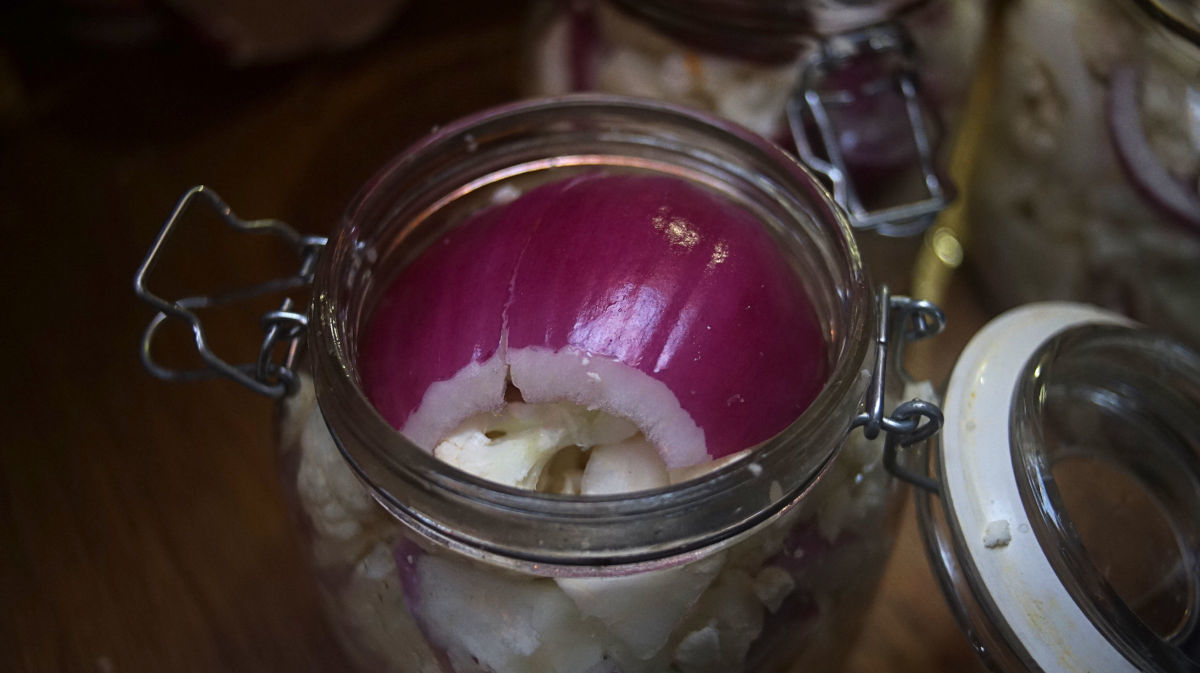
What can be used as a weight?
- Vegetable leaves, or skins. Not a weight perse, but a way to keep items submerged. If pickling cabbage, we sometimes add the outer leaf to the top, curled around the vegetables to keep them under the brine, and we do the same for red onion skins.
- Glass weights. Stores sell glass weights(pebbles) for pickling, they are sized to the mouth of a mason jar and are easy to clean, but they are not cheap (a friend gifted us his set after he stopped pickling).
- Upside down plate. Using a ceramic or glass plate, as is or with a weight overtop.
- Non-porous stones. Choose smooth, non-porous igneous stones (Silica/quartz based, granitic, and basaltic).
What to do when a jar is opened
Once we open a jar we usually go through them within a week, but they could last for months. It is necessary to take a few precautions:
- Use clean tools. Don't use a fork that's been in your mouth, and don't handle veg in the jar with your fingers
- Weigh veg down if in brine. Keeping everything submerged in the liquid will ensure they last. If too little remains in the jar but you're not ready to eat them, transfer to a smaller, clean jar.
- Close jar between servings. Don't leave it open unnecessarily.
- Store in a cool area. When opened, store in an area under 15°C.
Spices
Vegetables can be fermented alone, or with spices. Kimchi is typically spiced with chilies (dry or fresh), ginger, garlic, and onions, scallions, shallots, or leeks. Sauerkraut is often processed with juniper berries, caraway, dill, and celery seeds. Most of these traditional spices act as mold inhibitors, although this doesn't mean that they can prevent mold entirely, but it can help slow their growth.
Many spices have medicinal or antiviral properties that make them attractive additions to ferments, like turmeric. Whole cumin, coriander, fenugreek and mustard seeds add wonderful depth to a variety of vegetables. Experiment, see what you like best.
Fresh herbs are best for short-term fermentations.
Summer vegetables
There is a reason that people preserve food in the fall. Summer climate is less ideal to start fermentation, but also the microbiological flora of the soil during that time is less favorable.
It is possible to process summer vegetables, but they are not ideal for long-term storage.
Recommended vegetables
Below are the vegetables we have the most experience with and that we recommend. The best vegetable to start with when learning how to make lacto-fermentations is cabbage.
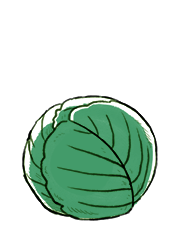
Cabbage. Make sauerkraut, or kimchi. This is a great vegetable to start with. It's cheap, and tastes amazing. Use red and green cabbage, both are good. Good for long-term storage. When cutting cabbage, slice it very thin, that way when you massage the salt into it the water will pull out of the strips more readily to create the brine. After first massaging the salt into the cabbage trips, let it rest for 20-30 minutes to further allow the salt to draw the water out. Allowing enough time will ensure that when you pack the sauerkraut or kimchi into the jars, that there will be enough liquid to cover everything.

Radish. Delicious when mixed into kimchi, or mixed with red onions in brine. Good for long-term storage.

Carrots. Whether fermented in brine or with salt, carrots are delicious. We prefer ours cut thin and processed with just salt, because they stay firm and have more flavor than in brine. They're also cheap, and plentiful. We like to add carrots to our kimchi, or to ferment it with garlic, ground mustard seeds and turmeric.

Yellow onion or red onion. Onions are tasty when fermented alone, or alongside other vegetables like cauliflower in brine. The red from red onions will leech into the brine and color the other vegetables, it looks great and tastes great too. Red onions are less 'aggressive' than yellow onions.

Cauliflower. When mixed with red onions in brine, cauliflower develops a deep and amazing citrusy flavor. The taste gets better after a month. They stay nice and crispy even after many weeks.

Eggplants. Eggplants mixed with spices like oregano, garlic, chili flakes and basil in brine taste fantastic! These are one of our favorites. (See notes in section below on preparing eggplant).
Other great veg to ferment include turnips, beets, parsnips, rutabaga, celery root, parsley root, and burdock.
Notes on specific vegetables

Beets. Beets are delicious, but have a very violent fermentation, due to the presence of sugar. The jar will ooze and spit, so be sure to place a plate under it. Beets with salt will develop a thick syrup that not everyone may enjoy, in that case it may be better to use brine.

Eggplants. Remove the skin. The skin doesn't soften much, and it is difficult to chew. It's also necessary to massage the salt into the cut eggplants beforehand to draw out the water, doing this will make them less bitter and they'll absorb the brine better. Eggplants don't keep as long as other veg; they'll get too acidic after 6 months.
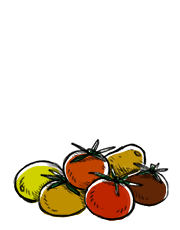
Tomatoes. Like eggplants, tomatoes become more acidic with time and shouldn't be left to ferment too long. Process in 2% Brine (1 litre of water and 20 grams of salt). Delicious with basil, garlic, mustard seeds and chili flakes.

Garlic. Best to use up early summer garlic for the best flavor. Lacto-fermenting garlic in brine mellows the pungency of the garlic. It's possible to use fermented garlic for nearly all of the same applications as raw garlic in a recipe.

Zucchini. Pick end of season zucchini, they'll keep longer. It isn't necessary to peel the zucchini. It's possible to pick it in chunks, or shredded to make a relish.

Bell peppers. Pick end of season peppers, they'll keep longer. Early summer peppers will soften too much. Pickle in 5 % brine. Use peppers that appear hydrated, and that aren't damaged or wrinkled. Don't use peppers that are overly sanitized (triple-washed that come in bags), they may not pickle well.

Cucumbers. Pick end of season cucumbers. Use very fresh cucumbers if you want them to stay crisp. Cut off the little brown end where the flower of the plant grows, apparently it helps them stay firm. Pickle in 5 % brine.

Mushrooms. Preparation depends on the kind of mushroom. Fermentation does 'cook' them, but some have problem compounds that might cause gastro-intestinal issues. For some varieties it might be necessary to cook them at high heat (boil) first. Also, many varieties break down during fermentation and become 'mush'.

Recipes
To start doing lacto-fermentation, we recommend these great recipes:
- kimchi recipe by Tout Cru! Fermentation.
- Achard de carottes a l'indienne (French) by Marie-Claire Frédéric.
- Lacto-fermented eggplant by Cultures for Health.
- Fermentation (recipe book) by Rachel de Thample.
Remember, fermentation is just controlled decay: your most important ingredient is time.
Resources
- Ni Cru Ni Cuit (French) by Marie-Claire Frédéric.
- The Art of Fermentation by Sandor Katz.
- The Messy World of Fermentation by Aaron Vansintjan for Low-Tech Magazine.
See a mistake? Make a pull request on Github. Or contact us on Mastodon. Information last updated on 2024.02.09.
Jump back to top.
